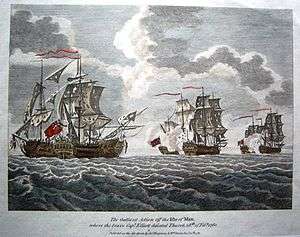HMS Blonde (1760)
HMS Blonde was a 32-gun fifth-rate warship of the British Royal Navy captured from the French in 1760. The ship wrecked on Blonde Rock with American prisoners on board. An American privateer captain, Daniel Adams, rescued the American prisoners and let the British go free. The captain's decision created an international stir. Upon returning to Boston, the American privateer was banished for letting go the British crew and he and his family became Loyalist refugees in Nova Scotia.[1] [2]

Career
On 24 February 1760, during the Seven Years' War, a British squadron under Captain John Elliot in HMS Aeolus met a French squadron under Captain François Thurot, who was aboard the French frigate Maréchal de Belleisle. In the subsequent Battle of Bishops Court, the British captured Maréchal de Belleisle (after Thurot was killed), Terpsichore, and Blonde. The Royal Navy took the latter two into service.
During the American Revolution, Blonde participated in the Battle off Liverpool, Nova Scotia in 1778. In 1779 Blonde, under the command of Andrew Barkley from Halifax Station, captured the Resolution under the command of Abel Gore off Halifax and were imprisoned in the Stone Jug (Halifax).[3][4]
On 25 January 1781 Blonde, Otter, and Delight, as well as some smaller vessels, carried 300 troops from Charleston to the Cape Fear River. The troops, together with 80 marines, temporarily occupied Wilmington, North Carolina on 28 January.[5] The object of the expedition was to establish sea communications with Lord Cornwallis and provide a base for the army, which was moving north.[6]
Fate
Blonde was wrecked on Blonde Rock, Nova Scotia on 21 January 1782.[7][8][9][10][11] The 60 American prisoners on board HMS Blonde made their way to Seal Island, Nova Scotia. American privateer Noah Stoddard in the Scammell reluctantly allowed the British crew to go free and return to Halifax in HMS Observer, which was involved in the Naval battle off Halifax en route.[12][13]
Legacy
- Namesake of Blonde Rock, Nova Scotia
References
- RADDALL, Thomas H. "Adventures of H.M.S. Blonde in Nova Scotia, 1778–1782". Collections of the Nova Scotia Historical Society, Vol. 35. 1966. pp. 29–52.
- Nova Scotia Gazette of June 4, 1782, p.75
- https://loyalist.lib.unb.ca/sites/default/files/Massachusetts%20Archives%20Content%20List.pdf
- Marines in the Revolution :a history of the Continental Marines in the American Revolution, 1775-1783, p. 352
- "No. 12162". The London Gazette. 13 February 1781. p. 4.
- Clowes & others (1899), p. 61.
- The Town and Country Magazine, Or, Universal Repository of ..., Volume 14, p. 502
- The Merchants' Magazine and Commercial Review, Volume 36, p. 162
- Wrongly reported by Colledge and Warlow as wrecked off Nantucket; mistake repeated by Hepper (1994), p.68.
- RADDALL, Thomas H. "Adventures of H.M.S. Blonde in Nova Scotia, 1778–1782". Collections of the Nova Scotia Historical Society, Vol. 35. 1966. Pp. 29–52.
- "HMS Blonde – 1782". Marine Heritage Database. Maritime Museum of the Atlantic. Retrieved 14 March 2018.
- Sacking of Lunenburg. Saga of the Seas, Archibald MacMechan, 1923
- Thomas Head Raddall. "Adventures of H.M.S. Blonde in Nova Scotia, 1778–1782". Collections of the Nova Scotia Historical Society. 1966.